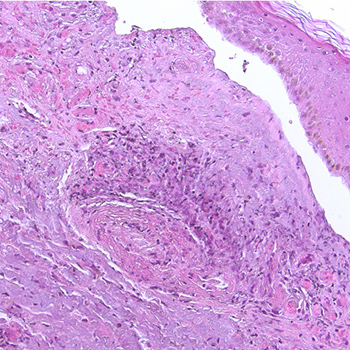Keywords
Vasculitis, ceftriaxone, dermatology
Abstract
We present a case of an 85-year-old woman diagnosed with uncomplicated pyelonephritis, who was treated with intravenous ceftriaxone. Her chronic medications were phenprocoumon, diltiazem and bisoprolol. During the infectious phase, the patient presented tachycardia – despite high-dose beta-blocker treatment – and developed left acute heart failure, with acute renal failure (pre-renal origin). After introduction of furosemide diuretic therapy, clinical conditions improved and better control of the volemic status and heart rate was achieved. Several days after ceftriaxone and digoxin therapy initiation, worsening multiple non-blanching palpable purpuric lesions with bullae and papules, limited to the lower extremities, were noted. Skin biopsy was performed and a diagnosis of leucocytoclastic vasculitis, with associated panniculitis, was made. Ceftriaxone was discontinued and systemic corticosteroids were introduced, with a clear improvement in the cutaneous condition.
References

Views: 1164
HTML downloads: 110
PDF downloads: 489
Published:
2020-03-05
Issue:
2020: Vol 7 No 4
(view)










